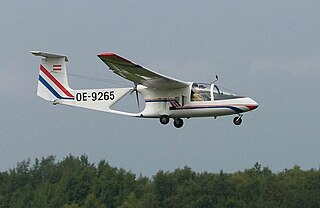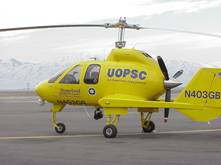
The Auster J/4 was a 1940s British single-engined two-seat high-wing touring monoplane built by Auster Aircraft Limited at Rearsby, Leicestershire.

The Auster J/1U Workmaster is a late 1950s British single-engined single-seat high-wing agricultural monoplane built by Auster Aircraft Limited at Rearsby, Leicestershire. Of traditional high-wing layout, it carries 90 gallons of spray fluid in a tank beside the pilot, an extra seat being provided for a passenger. The Lycoming 0-360-A engine of 180 h.p. driving a McCauley v.p. propeller giving it ample power; and slotted ailerons and balanced tail controls providing good handling. Oversize tyres were fitted. Take-off run at 2,550 lb gross weight and cruising speed at 65 per cent power are respectively 180 yd and 88 miles per hour (142 km/h). Britten-Norman spray gear was provided by Crop Culture, and this company ordered nine Workmasters.

The All American 10A Ensign was a two-seat light plane built in the United States shortly after World War II. It was a low-wing, all-metal cantilever monoplane with fixed tricycle undercarriage and which seated its pilot and passenger side by side under an expansive bubble canopy. Due to the glut of military surplus aircraft on the civil market after the war, All American was unable to attract buyers and no production ensued.

PZL.26 was a Polish sports plane built in 1934 by the Państwowe Zakłady Lotnicze. Ordered by the Ministry of Defence, it was specifically designed for the upcoming Challenge 1934 International Touring Aircraft Contest.
The Auster Avis was a four-seat light aircraft developed from the Auster Autocrat. It featured a redesigned fuselage incorporating four doors and a circular cross-section towards the tail, new undercarriage, and new wing flaps. It was planned in two versions, the Mk 1 for civil use, and the Mk 2 for military and air ambulance duties. However, only two prototypes were built, and Auster abandoned the project in favour of the Auster J-5 Autocar.

The Darmstadt D-22 was a sports-plane of Germany, designed and built by Akaflieg of Technische Universität Darmstadt.

The Brditschka HB-3, HB-21 and HB-23 are a family of motor gliders of unorthodox configuration developed in Austria in the early 1970s.

The Brügger MB-1, MB-2 and MB-3 Colibri is a family of small sports aircraft designed in Switzerland in the 1960s and 1970s for amateur construction.

The Christen Eagle, which later became the Aviat Eagle in the mid-1990s, is an aerobatic sporting biplane aircraft that has been produced in the United States since the late 1970s.
The Civil Aviation Department Revathi was a light utility aircraft designed in India principally for use by that country's flying clubs.

The PWS-20 was a Polish single-engine high-wing 8 passenger airliner, built in the PWS factory and when it made its first flight in 1929 it became the first Polish-designed transport aircraft to fly.

The Lederlin 380L is an unconventional light aircraft developed in France in the 1960s, and marketed for homebuilding.
The Montana Coyote is an American single-engined two-seat STOL aircraft designed for home building by Montana Coyote Inc. of Helena, Montana.

The Groen Hawk 4 was a single engine, pusher configuration, four seat autogyro built in the United States in the late 1990s. Three prototypes, two piston engined and one turboprop powered, were flown but the Hawk did not go into production.

The Jameson RJJ-1 Gipsy Hawk was a single-engine light aircraft intended to be homebuilt from plans. The prototype was designed and constructed in the U.S. by Richard Jameson in the late 1960s-early 1970s.

The Historical Ryan STA was an American homebuilt aircraft that was designed and produced by the Historical Aircraft Corporation of Nucla, Colorado. The aircraft was an 85% scale replica of the original Ryan STA and when it was available was supplied as a kit for amateur construction.

The Merville D.63 was a modification of the Druine D.62 Condor with a nosewheel undercarriage, modified fin and French engine. It flew in 1962.
The MMPL Kanpur was an Indian light four-seat aircraft, designed for service and agricultural work in the early 1960s. It is a rare example of an aircraft designed and built by a national air force for its own use.
The SNCASO SO.3050 was a two seat light touring aircraft that was designed and built in France towards the end of World War II. Only one was completed and that was soon abandoned.

The 1929 Curtiss Model 53 Condor, also known as the Curtiss Model 53 Condor 18 or the Curtiss CO Condor, was a civil passenger version of the Model 52 Condor bomber. A twin-engined biplane, it carried 18 passengers.















